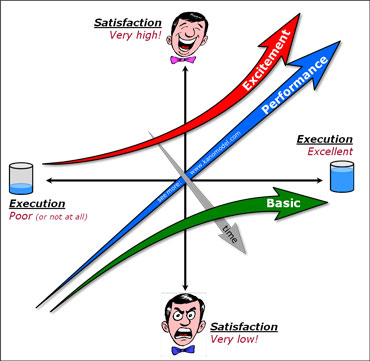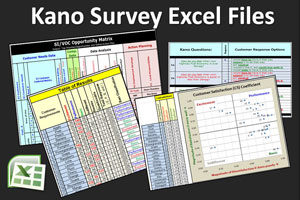About the Kano Model
 The Kano Model is a product or service development theory that helps you to determine which features you may want to include in a product or service to improve customer satisfaction.
The Kano Model is a product or service development theory that helps you to determine which features you may want to include in a product or service to improve customer satisfaction.
It continues to be a critical element found in the front end of Product and Service Development. The Kano Model may also be referred to as the Kano Model Analysis or Kano Model Survey; people have called it multiple different names. This website was created by Dave Verduyn, and Kano model enthusiast who wanted to create a quick and simple way to explain the Kano Model to his clients. After some success a decision was made to make the information, products and services open to the public at a minimal cost.
Kano Model’s Creator
Professor Noriaki Kano created the Kano Model in 1984 while studying the contributing factors to customer satisfaction and customer loyalty. The professor classified 5 unique categories of customer requirements, 3 of which you want to end up in your offering, and the other 2 should be taken out.
The Kano Model’s main objective is to help teams understand, classify, and integrate these 3 main categories of requirements into the products or services they are developing. The 5 categories of customer requirements are classified depending on their ability to create customer satisfaction or cause dissatisfaction. Knowing what category customer requirements fall into and the importance of each requirement can help prioritize development activities and determine what to include in your offering and where to spend resources improving these requirements.
Kano Model’s 5 Categories
The model describes these 5 categories on a set of axis. The y-axis is degree of satisfaction of the requirement; the x-axis is the level of fulfillment or execution of the requirement by the company. All 5 categories of requirements can be mapped on the axis:
Performance
Simply stated, these are the requirements the customers are able to articulate and are at the top of their minds when evaluating options. They are the most visible of the model’s requirements and the better they are performed, the more satisfaction they bring, conversely, the worse they are performed, the more dissatisfaction they bring. The Professor originally called these “One-Dimensional” because the better you execute these the more satisfaction from the customer you get.
Basic
Simply stated, these are the requirements that the customers expect and are taken for granted. When done well, customers are just neutral, but when done poorly, customers are very dissatisfied. Kano originally called these “Must-be’s” because they are the requirements that must be included and are the price of entry into a market.
Excitement
Simply stated, these are the requirements that are unexpected and pleasant surprises or delights. These are the innovations you bring into your offering. They delight the customer when there, but do not cause any dissatisfaction when missing because the customer never expected them in the first place. Kano originally called these “Attractive or Delighters” because that’s exactly what they do.
Indifferent
Simply stated, these are the requirements that the customers simply don’t care if they are present or absent, their satisfaction remains neutral under either circumstance.
Reverse
Simply stated, these are the requirements that cause dissatisfaction when present and satisfaction when absent. These are very rare but do happen occasionally.
Kano Model Survey
Kano also designed a special survey now known today as the Kano Model Survey. It can be designed and used to categorize all the requirements. In this survey, you formulate two strategic questions, a functional and dysfunctional representation of the requirement. Depending on how the respondents answer the question, the results will be aggregated and compiled into a graph, which clearly shows you which category the requirement/feature falls into.
Using this information along with some other voice of customer data, the development team can find gaps in their offering and potential holes in their customer research. Understanding how the list of requirements fits into the Model can also help a development team determine which of the requirements or features to include, which need enhancement, which need cost reduction, which should be excluded, and which to simply leave alone.
Want to Learn More?
Sometimes a brief explanation just isn’t enough. You can dive in just a little bit deeper and read about the Kano Model in detail.






March 22nd, 2016 at 9:24 am
OK.
April 3rd, 2016 at 1:45 pm
Thomas, did you get what you were looking for?